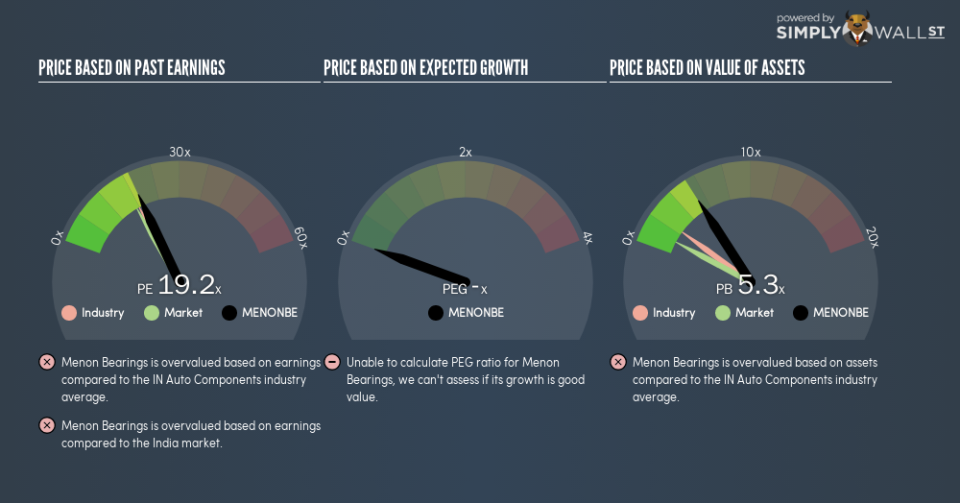Here’s What Menon Bearings Limited’s (NSE:MENONBE) P/E Is Telling Us

This article is for investors who would like to improve their understanding of price to earnings ratios (P/E ratios). We’ll look at Menon Bearings Limited’s (NSE:MENONBE) P/E ratio and reflect on what it tells us about the company’s share price. Menon Bearings has a price to earnings ratio of 19.22, based on the last twelve months. That is equivalent to an earnings yield of about 5.2%.
Check out our latest analysis for Menon Bearings
How Do I Calculate A Price To Earnings Ratio?
The formula for P/E is:
Price to Earnings Ratio = Price per Share ÷ Earnings per Share (EPS)
Or for Menon Bearings:
P/E of 19.22 = ₹85.9 ÷ ₹4.47 (Based on the year to September 2018.)
Is A High Price-to-Earnings Ratio Good?
A higher P/E ratio implies that investors pay a higher price for the earning power of the business. That isn’t necessarily good or bad, but a high P/E implies relatively high expectations of what a company can achieve in the future.
How Growth Rates Impact P/E Ratios
P/E ratios primarily reflect market expectations around earnings growth rates. That’s because companies that grow earnings per share quickly will rapidly increase the ‘E’ in the equation. That means unless the share price increases, the P/E will reduce in a few years. So while a stock may look expensive based on past earnings, it could be cheap based on future earnings.
It’s great to see that Menon Bearings grew EPS by 23% in the last year. And it has bolstered its earnings per share by 28% per year over the last five years. This could arguably justify a relatively high P/E ratio.
How Does Menon Bearings’s P/E Ratio Compare To Its Peers?
We can get an indication of market expectations by looking at the P/E ratio. The image below shows that Menon Bearings has a higher P/E than the average (17.9) P/E for companies in the auto components industry.
Its relatively high P/E ratio indicates that Menon Bearings shareholders think it will perform better than other companies in its industry classification. The market is optimistic about the future, but that doesn’t guarantee future growth. So investors should always consider the P/E ratio alongside other factors, such as whether company directors have been buying shares.
A Limitation: P/E Ratios Ignore Debt and Cash In The Bank
Don’t forget that the P/E ratio considers market capitalization. In other words, it does not consider any debt or cash that the company may have on the balance sheet. In theory, a company can lower its future P/E ratio by using cash or debt to invest in growth.
Spending on growth might be good or bad a few years later, but the point is that the P/E ratio does not account for the option (or lack thereof).
How Does Menon Bearings’s Debt Impact Its P/E Ratio?
Menon Bearings has net debt worth just 2.4% of its market capitalization. So it doesn’t have as many options as it would with net cash, but its debt would not have much of an impact on its P/E ratio.
The Bottom Line On Menon Bearings’s P/E Ratio
Menon Bearings has a P/E of 19.2. That’s higher than the average in the IN market, which is 17.1. While the company does use modest debt, its recent earnings growth is impressive. So it does not seem strange that the P/E is above average.
Investors have an opportunity when market expectations about a stock are wrong. If the reality for a company is better than it expects, you can make money by buying and holding for the long term. So this free visual report on analyst forecasts could hold they key to an excellent investment decision.
Of course you might be able to find a better stock than Menon Bearings. So you may wish to see this free collection of other companies that have grown earnings strongly.
To help readers see past the short term volatility of the financial market, we aim to bring you a long-term focused research analysis purely driven by fundamental data. Note that our analysis does not factor in the latest price-sensitive company announcements.
The author is an independent contributor and at the time of publication had no position in the stocks mentioned. For errors that warrant correction please contact the editor at editorial-team@simplywallst.com.

